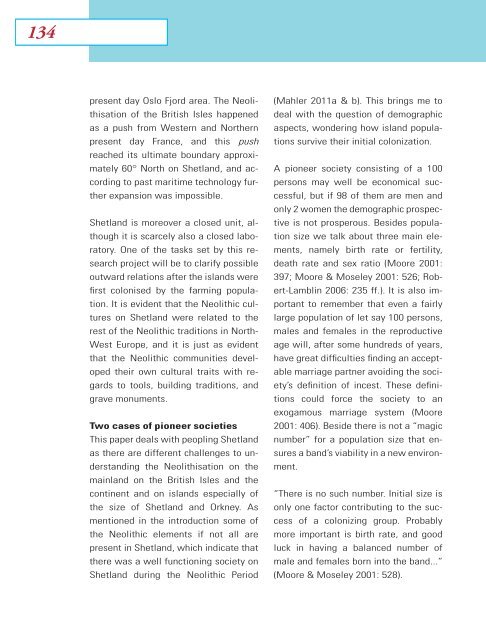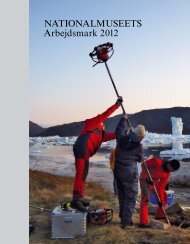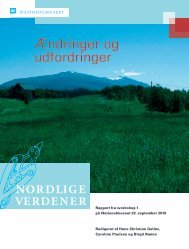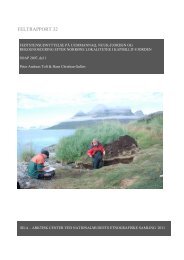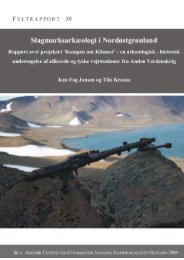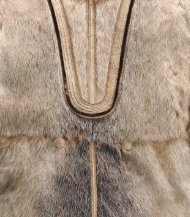The Border of Farming and the Cultural Markers - Nordlige Verdener
The Border of Farming and the Cultural Markers - Nordlige Verdener
The Border of Farming and the Cultural Markers - Nordlige Verdener
You also want an ePaper? Increase the reach of your titles
YUMPU automatically turns print PDFs into web optimized ePapers that Google loves.
134<br />
present day Oslo Fjord area. <strong>The</strong> Neolithisation<br />
<strong>of</strong> <strong>the</strong> British Isles happened<br />
as a push from Western <strong>and</strong> Nor<strong>the</strong>rn<br />
present day France, <strong>and</strong> this push<br />
reached its ultimate boundary approximately<br />
60° North on Shetl<strong>and</strong>, <strong>and</strong> according<br />
to past maritime technology fur<strong>the</strong>r<br />
expansion was impossible.<br />
Shetl<strong>and</strong> is moreover a closed unit, although<br />
it is scarcely also a closed laboratory.<br />
One <strong>of</strong> <strong>the</strong> tasks set by this research<br />
project will be to clarify possible<br />
outward relations after <strong>the</strong> isl<strong>and</strong>s were<br />
first colonised by <strong>the</strong> farming population.<br />
It is evident that <strong>the</strong> Neolithic cultures<br />
on Shetl<strong>and</strong> were related to <strong>the</strong><br />
rest <strong>of</strong> <strong>the</strong> Neolithic traditions in North-<br />
West Europe, <strong>and</strong> it is just as evident<br />
that <strong>the</strong> Neolithic communities developed<br />
<strong>the</strong>ir own cultural traits with regards<br />
to tools, building traditions, <strong>and</strong><br />
grave monuments.<br />
Two cases <strong>of</strong> pioneer societies<br />
This paper deals with peopling Shetl<strong>and</strong><br />
as <strong>the</strong>re are different challenges to underst<strong>and</strong>ing<br />
<strong>the</strong> Neolithisation on <strong>the</strong><br />
mainl<strong>and</strong> on <strong>the</strong> British Isles <strong>and</strong> <strong>the</strong><br />
continent <strong>and</strong> on isl<strong>and</strong>s especially <strong>of</strong><br />
<strong>the</strong> size <strong>of</strong> Shetl<strong>and</strong> <strong>and</strong> Orkney. As<br />
mentioned in <strong>the</strong> introduction some <strong>of</strong><br />
<strong>the</strong> Neolithic elements if not all are<br />
present in Shetl<strong>and</strong>, which indicate that<br />
<strong>the</strong>re was a well functioning society on<br />
Shetl<strong>and</strong> during <strong>the</strong> Neolithic Period<br />
(Mahler 2011a & b). This brings me to<br />
deal with <strong>the</strong> question <strong>of</strong> demographic<br />
aspects, wondering how isl<strong>and</strong> populations<br />
survive <strong>the</strong>ir initial colonization.<br />
A pioneer society consisting <strong>of</strong> a 100<br />
persons may well be economical successful,<br />
but if 98 <strong>of</strong> <strong>the</strong>m are men <strong>and</strong><br />
only 2 women <strong>the</strong> demographic prospective<br />
is not prosperous. Besides population<br />
size we talk about three main elements,<br />
namely birth rate or fertility,<br />
death rate <strong>and</strong> sex ratio (Moore 2001:<br />
397; Moore & Moseley 2001: 526; Robert-Lamblin<br />
2006: 235 ff.). It is also important<br />
to remember that even a fairly<br />
large population <strong>of</strong> let say 100 persons,<br />
males <strong>and</strong> females in <strong>the</strong> reproductive<br />
age will, after some hundreds <strong>of</strong> years,<br />
have great difficulties finding an acceptable<br />
marriage partner avoiding <strong>the</strong> society’s<br />
definition <strong>of</strong> incest. <strong>The</strong>se definitions<br />
could force <strong>the</strong> society to an<br />
exogamous marriage system (Moore<br />
2001: 406). Beside <strong>the</strong>re is not a “magic<br />
number” for a population size that ensures<br />
a b<strong>and</strong>’s viability in a new environment.<br />
“<strong>The</strong>re is no such number. Initial size is<br />
only one factor contributing to <strong>the</strong> success<br />
<strong>of</strong> a colonizing group. Probably<br />
more important is birth rate, <strong>and</strong> good<br />
luck in having a balanced number <strong>of</strong><br />
male <strong>and</strong> females born into <strong>the</strong> b<strong>and</strong>...”<br />
(Moore & Moseley 2001: 528).


